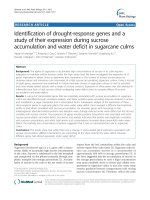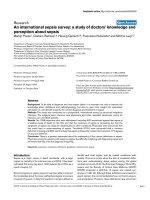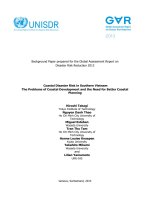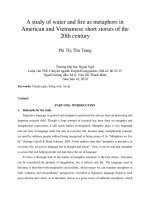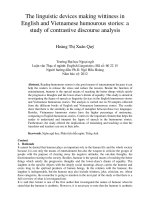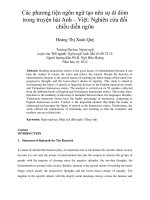MARKETING THEORIES AND CONCEPTS FOR THE INTERNATIONAL CONSTRUCTION INDUSTRY A STUDY OF THEIR APPLICABILITY AT THE GLOBAL, NATIONAL AND CORPORATE PERSPECTIVES
Bạn đang xem bản rút gọn của tài liệu. Xem và tải ngay bản đầy đủ của tài liệu tại đây (30.69 MB, 569 trang )
MARKETING THEORIES AND CONCEPTS FOR THE
INTERNATIONAL CONSTRUCTION INDUSTRY : A STUDY OF
THEIR APPLICABILITY AT THE GLOBAL, NATIONAL AND
CORPORATE PERSPECTIVES
BY
LOW SUI PHENG
A thesis presented to the University of London as part of the
requirements for the award of the degree of
Doctor of Philosophy
Bartlett School of Architecture and Planning
University College London
February 1990
10141)74)
utAil
The role and applicability of marketing theories and concepts are explored at three
levels of analysis for the international construction industry. Developments of the
theoretical constructs are traced as marketing evolves to encompass. an international
perspective. The relevance and need for marketing in the construction industry was
examined. Four schools of thought were identified before the strategic significance
of marketing in the market place was reviewed and argued. The marketing
implications of financing, countertrade, technology transfer and joint venture were
considered.
At the global level, the theoretical issues and applications of Marketing Information
Systems are extended for the international construction industry. An analysis of
global construction markets in value added terms was conducted, disaggregated
according to types of economies, regions and political groupings. The markets in
Asean and the EC were examined. A global summary of the world's construction
industries was extracted diagrammatically for 19 regions and 180 countries and
territories.
The influence of marketing and construction on economic development was explored
at the national level. A coalescing model was adopted to provide a proposed synthesis
of the tripartite relationship between marketing, construction and economic
development. The cumulative events leading to the evolution of the construction
exports industry in Singapore was studied to highlight the governmental role in
nurturing and promoting a national marketing drive overseas for construction
services.
At the corporate level, the theoretical foundations for organising marketing
activities in international construction firms were examined. Empirical evidence
from a field study in the United Kingdom shows that the Contingency Approach
appears to be valid for structuring marketing organisations in international
construction firms. Nonetheless, at a more detailed level of analysis, the geographical
structure seems to be well-placed for organising foreign construction marketing
activities.
The three-pronged approach adopted in this thesis shows how marketing theories
and concepts may be appropriately applied within the global, national and corporate
contexts of the construction industry.
Keywords : Marketing
International Construction
Global Markets
Singapore
Marketing Organisations
2
It is certainly not an easy task to pen the names of all those who have contributed
and rendered generous assistance to make this thesis possible. I am indeed grateful to
everyone who have helped in one way or another.
First and foremost, Mr. John Andrews has been most considerate and helpful in his
supervision of my progress. His uncanny ability to provide subtle but yet
.encouraging advice, particularly at times of despair, will continue to awe me for a
long time to come.
Much co-operation have been received from the academic staff of other universities
and business schools as well as practitioners from the industry who have generously
and patiently gave of their time to attend to all my queries and clarify my thoughts.
The Construction Industry Group of the Chartered Institute of Marketing, the Export
Group for the Constructional Industries, the Market Research Society, the Building
Employers Confederation and the Singapore High Commission in London, in
particular, must be singled out for special mention. The librarians at the London
Business School and the Export and Marketing Intelligence Library of the
Department of Trade and Industry have been most helpful in guiding me to the right
source of information to be found within their first class facilities. I am also grateful
to all those companies, both in the United Kingdom and in Singapore, who have
responded to my study and who have afforded me the opportunities to learn and
understand their marketing organisations and operations. For reason of
confidentiality, their anonymity have to be respected and maintained.
I am very much indebted to the Overseas Development Administration for their award
of the ODA Shared Scholarship for my first year of study in England. The National
University of Singapore has provided the necessary financial support for subsequent
years under the NUS Overseas Graduate Scholarship Scheme. Last, but not least, the
expenses for my fieldwork in the United Kingdom have been defrayed by an award
under the Sir Christopher Cox Memorial Fund (New College, Oxford). The generosity
of the Trustees for this Fund is hereby acknowledged.
Finally, my wife Ong Bee has been most extraordinary in understanding and coping
with all the demands typical of most serious research students. I would like to
dedicate this thesis to her for accommodating all these in her stride.
I have fought a good fight,
I have finished my course,
I have kept the faith.
2 Timothy 4:7
May the grace of God sustain all of us now and forever more.
Low Sui Pheng
Knightsbridge, London
February 1990
3
Page
Abstract
Acknowledgements
Contents
List of Figures
List of Tables
List of Appendices
List of Abbreviations
2
3
4
14
19
22
23
CHAPTER ONE: INTRODUCTION
27
1.1 Purpose
27
1.2 Background
27
1.3 Definition of marketing
29
1.4 Prelude
31
1.5 Economics and marketing
34
1.6 Marketing and the firm
37
1.7 Marketing and economic development
39
1.8 Research framework, methodologies and objectives
44
1.9 Summary
49
Footnotes
50
References
50
CHAFFER TWO: A REVIEW OF SOME INFLUENTIAL APPROACHES TO THE
THEORETICAL CONSTRUCTS OF MARKETING
54
2.1 Background
54
2.2 The economic influence
57
2.3 Aftermath of the "Marketing Myopia"
59
2.4 Approaches to the theory of marketing
61
2.4.1
Bartels' (1962, 1965, 1968) contributions
61
2.4.2 Axioms of Sheth and Gardner (1982)
63
2.4.3
Hunt's (1976) categorical dichotomies
65
2.4.4
Risley's (1972) approaches
66
2.4.5
Keith's (1960) revolutionary eras
68
2.5 Marketing mix
69
2.6 The Broadening Concept
70
2.7 Other conceptual approaches
72
4
2.7.1
72
Ecological marketing
2.7.2 Macromarketing
74
2.7.3 Comparative marketing
74
2.8 Marketing's link with practice
74
2.9 Summary
76
References
77
' CHAPTER THREE: A THEORETICAL PERSPECTIVE OF INTERNATIONAL
MARKETING
80
3.1
80
Theories of international trade
3.2 Historical overview of international trade
82
3.3 Theoretical dimensions of international marketing
85
3.4 Standardisation of international marketing practices
89
3.5 International Product Life Cycle (PLC) Concept
91
3.6 The EPRG Schema
93
3.7 Marketing connotations in the Eclectic Theory
93
3.8 Why firms venture overseas ?
95
3.9 Summary
96
References
98
CHAPTER FOUR : THE RELEVANCE OF MARKETING IN CONSTRUCTION
100
4.1
100
Does marketing apply to the construction industry ?
4.2 The need for marketing in construction
102
4.3
108
Construction marketing : tangible or intangible ?
4.4 Construction marketing : products or services ?
111
4.5 The Building Client : Industrial purchaser or consumer ?
116
4.5.1
118
Derivation of demand'
4.5.2 Industrial markets tend to be dominated by rational
buying motives
118
4.5.3
Buyer concentration
118
4.5.4
The greater scale of industrial purchase
118
4.5.5
Industrial products are technically more sophisticated
118
4.5.6 The group buying process for industrial products
119
4.5.7
119
The greater role of services
5
4.5.8 The importance of financial repayment terms and arrangements
for the extension of credit
119
4.6 The industrial decision-making process
119
4.7 Approaches to marketing within the construction industry
120
4.7.1
4.8
121
Suppliers
4.7.2 Builder merchants
121
4.7.3
Plant hiring firms
121
4.7.4
Specialist firms
122
4.7.5
Speculative house builders
122
4.7.6
System builders
122
4.7.7 Renovation, repairs and maintenance companies
122
4.7.8
General building contractors
122
4.7.9
Civil engineering contractors
122
4.7.10 Professional consultancies
123
Contract strategies and their effects on marketing
123
4.9 Summary
125
References
126
CHAPTER FIVE : THE FOUR SCHOOLS OF MARKETING THOUGHT IN CONSTRUCTION
128
5.1 Background
128
5.2 Marketing not applicable in construction ?
128
5.2.1
Apparent lack of understanding
128
129
5.2.2 The influence from price
5.3 Marketing applicable in construction but not well understood
133
5.4 Marketing applied in construction but not recognised as such
135
5.5 Marketing applicable to construction
137
5.6 Some general observations
139
5.7 Summary
145
Footnotes
147
References
147
CHAPTER SIX : THE SIGNIFICANCE OF MARKETING IN CONSTRUCTION
149
6.1 The current position
149
6.2 Marketing and tendering
152
6
6.3 The issue of lowest price
156
6.4 A review of strategic thinking
158
6.5
161
Marketing strategies
6.6 Strategic marketing versus marketing management
164
6.7 Market segmentation
166
.6.8 Market share
167
6.9 Entry barriers
168
6.10 Contributions from military strategies
168
6.11 Problems in construction export marketing
169
6.11.1 Entry modes
172
6.11.2 Marketing risks
173
6.11.3 Host country's reactions
173
6.11.4 Factors affecting international contracting opportunities
174
6.12 Marketing practices in construction exports
176
6.13 Summary
184
References
186
CHAPTER SEVEN: THE MARKETING IMPLICATIONS OF FINANCING,
COUNTERTRADE, TECHNOLOGY TRANSFER AND JOINT VENTURE 191
7.1
191
Some financing aspects
7.2 Countertrade
193
7.3 Technology transfer
196
7.4 Joint venture
199
7.5 Summary
201
References
203
CHAPTER EIGHT : MARKETING INFORMATION SYSTEMS (MKIS)
205
8.1 The need for an information system
205
8.2 Contributions from marketing research
210
8.3 What a Marketing Information System (MKIS) is ?
215
8.4 Secondary sources of information
223
8.5 MKIS : The extent of use
225
8.5.1
Formal versus informal approach
7
225
8.5.2
Cost-benefit analysis from a systemic approach
226
8.5.3
Socio-political influence on a MKIS
227
8.6
Problems in developing an international MKIS
228
8.7
Summary
232
References
234
CHAPTER NINE: THE APPLICATION OF MIUS FOR INTERNATIONAL
CONSTRUCTION
237
9.1
The role of MKIS in construction management
237
9.2
Sources and types of data for a MIUS relating to international
construction
238
9.2.1
Added refinement of statistical data
239
9.2.2
Obscurity of country-based statistical data
240
9.2.3
Statistical accuracy
240
9.2.4
Extraction of statistical data from various sources
241
9.2.5
The use of past macroeconomic data
241
9.2.6
The use of surrogate measures
242
9.3
The use of national accounts statistics
243
9.4
Computerised data bases and spreadsheet models in international
marketing research
245
9.5
A question of crudity and acceptability
246
9.6
Methods of approach
251
9.6.1
Logic flow
252
9.6.2
Level of disaggregation
2.52
9.6.3
Absolute and relative measures over time
253
9.6.4
The qualitative aspects
254
9.6.5
A ranking approach
254
9.6.6
Analysis of trends
255
9.7
Limitations
256
9.8
Summary
257
Footnotes
258
References
258
8
CHAPTER TEN: AN ANALYSIS OF GLOBAL CONSTRUCTION MARKETS:
A MKIS APPROACH USING UN AND OTHER RELATED STATISTICS
260
10.1 The stages involved
260
10.2 Analysis at global level
263
10.3 Analysis based on types of economies
266
10.3.1 Estimated value added by construction
266
10.3.2 Annual growth rates over preceding year
269
10.3.3 Percentage shares of world construction volume
269
10.4 Estimates based on regional classifications
275
10.4.1 Estimated value added by construction
275
10.4.2 Annual growth rates over preceding year
279
10.4.3 Percentage shares of world construction volume
284
290
10.5 Estimates based on six political groupings
10.5.1 Estimated value added by construction
291
10.5.2 Annual growth rates over preceding year
292
10.5.3 Percentage shares of world construction volume
294
295
10.6 The trends in Asean
10.6.1 Asean in general
297
10.6.2 Estimated value added by construction for member countries
of Asean
298
10.6.3 Annual growth rates for member countries of Asean
298
10.6.4 Percentage shares of value added in construction by member
countries of Asean
299
302
10.7 The trends in the EC
10.7.1 The EC in general
303
10.7.2 Estimated value added by construction for member countries
of the EC
305
10.7.3 Annual growth rates for member countries of the EC
306
10.7.4 Percentage shares of value added in construction by member
countries of the EC
309
10.8 A comparison of proportionalities in Asean and the EC
313
10.9 Ranked classifications at country levels
315
10.10 A measure of regressional closeness of fit
323
9
10.11 Closeness of fit results for regressional construction value added and
regressional construction value added indices
325
10.12 Closeness of fit results for regressional global volume
percentage and
regressional global volume percentage indices
329
10.13 A summary of global construction markets' size and growth trends
335
10.13.1 Regional contributions to increase of global construction
volume
337
10.13.2 A global summary of regional construction
340
10.13.3 A country-by-country approach
342
10.14 Summary
345
Footnotes
347
References
349
CHAPTER ELEVEN: THE INFLUENCE OF MARKETING AND CONSTRUCTION
ON ECONOMIC DEVELOPMENT
350
11.1 What is economic development ?
350
11.2 Marketing's role in economic development
350
11.3 Beyond recognition
353
11.4 Manifestations of marketing in construction
355
11.5 Synthesising marketing, construction and economic development
358
11.6 Government's unification role
365
11.7 Summary
368
References
369
CHAPTER TWELVE: EXPORT MARKETING OF CONSTRUCTION SERVICES:
THE CASE OF SINGAPORE
371
12.1 Introduction
371
12.2 A brief history of Singapore
374
12.3 Foreign inputs to construction in Singapore
374
12.4 Singapore economy : industrialisation and development
375
12.5 Construction in the Singapore economy
381
12.6 Major construction problems and corrective measures taken by
the Singapore government
388
12.6.1 The push towards mechanisation
389
12.6.2 The Preferential Margin Scheme
390
12.6.3 HDB's role
390
10
12.6.4 Manpower shortages
392
12.6.5 Rationalisation and the move towards exports
12.7 Debate on the open-door policy
392
395
12.7.1 Protectionism
397
12.7.2 International/Regional co-operation
398
12.7.3 Foreign - Local market share
400
12.7.4 An outbreak of liquidation
402
12.7.5 Reactions from Singaporean contractors
12.7.6 The Contractors - Government dialogues
12.7.7 The Consultants - Government dialogues
403
405
408
12.8 Government's role in promoting export marketing
410
12.8.1 General role : Laying the groundwork
411
12.8.1.1 The Economic Development Board (EDB)
12.8.1.2 The Trade Development Board (TDB)
413
414
12.8.1.3 The Export Credit
Insurance Corporation of Singapore
Ltd. (EC1CS)
12.8.2 Specific role for the construction industry
416
416
12.8.2.1 Government's response to the construction slow-down
in the 1980s
12.8.2.2 Indications in the export direction
12.8.2.3 TDB's role in promoting construction exports
12.8.2.4 Overseas construction missions
417
419
421
12.8.2.5 The Construction Industry Development Board (CIDB)
12.8.2.6 The Construction Exports Promotion Unit (CEPU)
12.8.2.7 Assistance and incentives in construction exports
12.8.3 Paving the way ahead for construction exports
12.9 The major local contractors
12.10 The results
12.12 Summary
422
423
425
427
428
12.11 A synthesis of the national marketing effort
416
429
433
439
Footnotes
440
References
453
11
CHAPTER THIRTEEN: ORGANISATION OF MARKETING IN INTERNATIONAL
CONSTRUCTION FIRMS : THEORY
456
13.1
Introduction
456
13.2
Organisation issues and implications
457
13.3
Traditional approaches to management theories
458
13.4
13.3.1
The Classical Approach
459
13.3.2
The Human Relations Approach
460
461
Organisation structures
13.4.1
Some wider implications
461
13.4.2
The structural options available
463
13.5
A critique of traditional management theories in organisation design
465
13.6
Structure and technology : Woodward (1958)
467.
13.7
Mechanistic and organic structures : Burns and Stalker (1961)
469
13.8
Differentiation and integration : Lawrence and Lorsch (1967)
470
13.9
A Contingency Approach
472
13.10 A critique of the Contingency Approach to organisation design
476
13.11 Organising international marketing departments
479
13.12 Steps in designing marketing organisations
481
13.13 A Marketing Theory of the firm
487
13.14 A review of some of the relevant empirical studies
489
13.14.1 British Institute of Management (1970)
489
13.14.2 Lansley, Sadler and Webb (1974)
490
13.14.3 Bell (1981)
490
13.14.4 Invig (1984)
491
13.15 Some conclusions on the Contingency Approach applied to
organisation design
491
13.16 Prelude to field study
494
13.17 Summary
495
References
496
CHAPTER FOURTEEN: ORGANISATION OF MARKETING IN INTERNATIONAL
CONSTRUCTION FIRMS : PRACTICE
499
14.1
Research methodology
499
14.2
Details of respondents
500
12
14.3 Geographical operations of respondent companies
501
14.4 Type of work carried out by respondent companies
503
14.5 Respondents' perceptions of marketing
504
14.6 Parent and subsidiary companies
505
14.7 Marketing overseas
507
.14.8 A preference for localisation
508
14.9 Organisation design for overseas construction marketing
510
14.10 Centralisation versus decentralisation
512
14.11 Problems with changes in structures
513
14.12 Summary
514
Reference
515
CHAPTER I-WIELN : CONCLUSIONS AND RECOMMENDATIONS
516
15.1 Introduction
516
15.2 The global analysis
519
519
15.2.1 Limitations
15.3 Singapore's national marketing efforts
522
15.4 The corporate marketing organisation
531
15.5 Conclusion
534
15.6 Recommendations for further research
534
Footnotes
539
References
539
Bibliography
543
Bibliography (Singapore economy and construction industry)
552
Appendix 1
563
Appendix 2
566
13
LIST OF FIGURES
Page
Figure
1.1
The Three-pronged research framework
45
1.2
Thesis framework
48
2.1
The Product Life Cycle Concept
71
3.1
The different stages reached on the Product Life Cycles within
the different markets
92
4.1
The Marketing Continuum
106
4.2
The interface between products and services
109
4.3
The holistic model of marketing flow system in construction
116
4.4
Decision centres for the buying function
121
5.1
A "Market-Poduct-Service" Matrix for the construction industry
142
5.2
The relationship between product and service marketing in the
construction industry
145
6.1
A simplified view of strategic analysis
160
6.2
The marketing strategy process
164
6.3
The marketing strategy factors
165
7.1
Types of countertrade arrangements
195
8.1
The Impact-Probability matrix
209
8.2
A MKIS bridge between the environment and the decision-maker
217
8.3
Major components of a MKIS
218
9.1
The three ways of estimating GDP / GNP at market prices
244
9.2
The International Portfolio Model
250
10.1
Estimated global VA by construction between 1970 and 1984
265
10.2
Annual growth rates for world VA by construction over preceding
year
265
Estimated VA by construction (US$m) between 1970 and 1984:
classified according to types of economies
269
Growth rates (%) over preceding year for estimated VA in
construction between 1970 and 1984: classified according to types
of economies
270
Percentage shares of estimated global VA in construction : classified
according to types of economies
273
10.3
10.4
10.5
14
Figure
10.6
10.7
10.8
.10.9
10.10
10.11
10.12
10.13
10.14
10.15
10.16
10.17
10.18
10.19
10.20
10.21
10.22
Page
Mean percentage share of world construction VA between
1970
and 1984 : classified according to types of economies
273
Estimated VA by construction (USSm)
: classified according to
regions - Europe and the USSR
277
Estimated VA by construction (USSm) : classified according to
regions - Asia and the Pacific
278
Estimated VA by construction (US$m) : classified according to
region - America
278
Estimated VA by
construction (US$m) : classified according to
region - Africa
279
Growth rates (%) over preceding year for estimated VA by
construction between 1970 and 1984: Europe and the USSR
281
Growth rates (%) over preceding year for estimated VA by
construction between 1970 and 1984: Asia and the Pacific
282
Growth rates (%) over preceding year for estimated
VA by
construction between 1970 and 1984 : America
282
Growth rates (%) over preceding year for estimated
VA by
construction between 1970 and 1984 : Africa
283
Regional percentage share
of global VA in construction :
Europe and the USSR
284
Regional percentage share of global VA in construction :
Asia and the Pacific
286
Regional percentage share of global VA in construction :
America
286
Regional
percentage share of global VA in construction :
Africa
287
Mean percentage share of world construction
VA between 1970 and
1984: classified according to regions
288
Estimated VA by construction
(US$m) : classified according to
political groupings
292
Annual growth rates (%) for VA by construction over preceding
year : classified according to political groupings
294
Percentage shares of global VA in construction : classified according
to political groupings
296
10.23
Estimated VA in construction in Asean
. 297
10.24
Annual growth rates (%) for VA by construction over preceding
year in Asean
15
298
Figure
10.25
Page
Estimated VA in construction (US$m) between 1970 and 1984 for
member countries of Asean
299
Countries' percentage shares of estimated global VA by
construction in Asean
302
Countries'
percentage shares of estimated VA by construction
in Asean
304
Member countries' mean percentage shares of Asean construction
VA between 1970 and 1984
304
10.29
Estimated VA by construction in the EC
305
10.30
Annual growth rates for VA by construction over preceding year
in the EC
306
Estimated VA in construction (US$m) between 1970 and 1984 for
member countries of the EC
308
Countries' percentage shares of estimated global VA by construction
in the EC
312
Countries' percentage shares of estimated VA by construction
in the EC
312
Member countries' mean percentage shares of the EC construction
VA between 1970 and 1984
314
Percentage shares of global VA in construction : A comparison
between Asean, EC, Japan and USA
315
Cumulative percentage total versus correlation coefficients for
construction VA regressional trends
326
10.37
Correlation coefficients versus construction VA regressional trends
328
10.38
Correlation coefficients versus construction VA indices regressional
trends (Base year = 1970)
328
Cumulative percentage total versus correlation coefficients
for
percentages of global volume regressional trends
330
Correlation coefficients
versus global volume percentage
regressional trends
333
Correlation coefficients versus global volume
percentage indices
regressional trends (Base year = 1970)
333
Average percentage shares of world value added by construction
between 1970 and 1984 for nineteen global regions
336
Average annual percentage growth of value added by construction
over preceding year between 1970 and 1984 for nineteen
global regions
338
10.26
10.27
.10.28
10.31
10.32
10.33
10.34
10.35
10.36
10.39
10.40
10.41
10.42
10.43
16
Figure
10.44
Page
Regional average annual percentage growth of value added
by
construction over preceding year between 1970 and 1984
339
Regional percentage contribution to increase
of world value added
by construction between 1970 and 1984
341
Average percentage shares of world value added by construction
between 1970 and 1984 for one hundred and eighty countries
and territories
343
Average annual percentage growth of value added by construction
over preceding year between 1970
and 1984 for one hundred and
eighty countries and territories
344
The link between construction, marketing and economic
development
358
11.2
Coalescing trends
363
11.3
A matrix for planning and identifying opportunities in construction
364
12.1
The basic M-H Model for developing countries
372
12.2
The revised M-H Model
372
12.3
GDP per capita for Singapore, developing market economies,
developed market economies, market economies and the world
between 1960 and 1985
379
GNP per capita (in current US$) for Switzerland, US, Japan, UK,
Singapore, Italy,
Ireland, Spain, Greece and South Korea for year
1960 and 1986
380
Gross Domestic Product, Capital Formation in construction and
works, and value added in construction in the Singapore economy
between 1960 and 1988 (at constant 1968 market prices)
383
Main components of GDFCF - Total construction and works,
machinery and equipment, and transport equipment between
1960 and 1987
384
Residential buildings, non-residential buildings, and other
construction and works in GDFCF in Singapore between 1960 and
1987
385
Value of buildings commenced in Singapore between 1963 and
1987 - Total, public and private
386
Value of buildings completed in Singapore between 1963 and
1987 - Total, public and private
387
Total value of buildings commenced and completed in Singapore
between 1963 and 1987
388
CIDB's organisational structure in 1984
424
10.45
10.46
10.47
11.1
12.4
12.5
12.6
12.7
12.8
12.9
12.10
12.11
17
Figure
Page
Value of overseas projects
won by Singaporean contractors
between 1984 and 1988
431
A synthesis of building activities, construction exports volume
and promotional measures in Singapore
437
13.1
The Single Marketing Executive
482
13.2
Functional structure
483
• 13.3
Divisional structure
483
13.4
Products structure
484
13.5
Geographical structure
484
13.6
Matrix structure
485
13.7
Complex structure
486
13.8
Components of a marketing theory of the firm
488
13.9
A situational perspective model
494
15.1
Scenario A - A Balanced View
524
15.2
Scenario B - Weighted Towards Construction
525
15.3
Scenario C - Weighted Towards Marketing
526
15.4
Scenario D - A Deficiency Model
527
12.12
12.13
18
LIST OF TABLES
Table
4.1
9.1
10.1
10.2
10.3
10.4
10.5
10.6
10.7
10.8
10.9
10.10
10.11
10.12
10.13
Page
The marketing orientation
of operating units within the
construction system
124
Analytical methods
for the identification of export market
opportunities
251
Estimated global VA by construction and growth rates over
preceding years
264
Estimated VA by construction (USSm) between
1970 and 1984:
classified according to types of economies
267
Growth rates (%) over preceding year for estimated VA by
construction between
1970 and 1984 : classified according to
types of economies
268
Estimated VA in construction expressed as a percentage of global
volume between
1970 and 1984: classified according to types
of economies
271
Estimated VA in construction expressed as a percentage of global
VA by construction between 1970
and 1984: classified
according to types of economies
272
Estimated VA by construction (US$m) between 1970 and 1984:
classified according to regions
276
Growth rates (%) over preceding year for estimated VA by
construction
between 1970 and 1984: classified according to
regions
280
Estimated VA by construction expressed as a percentage of global
VA in construction
between 1970 and 1984 : classified according
to regions
285
Estimated VA in construction expressed as a percentage of
estimated global VA by construction between 1970 and 1984:
classified according to regions and
ranked in descending
order of mean percentage share
289
Estimated VA by construction (US$m) for Asean, CARICOM,
CMEA, EC, EFTA and LAS between 1970 and 1984
291
Growth rates (%) over preceding year for estimated VA by
construction between
1970 and 1984 : classified according to
political groupings
293
Estimated VA by construction expressed as a percentage of global
VA in construction between
1970 and 1984: classified according
to political groupings
295
Growth rates (%) over preceding year for estimated VA by
construction between
1970 and 1984 : classified according to member
countries of Asean
300
19
Table
10.14
Page
Countries ranked in regressional trends of VA by construction
in Asean
301
Countries ranked in regressional trends of construction VA indices
in Asean
301
Estimated VA in construction expressed as a percentage of Asean's
VA by construction between 1970 and 1984 : classified according
to member countries of Asean
303
Annual growth rates for VA by construction over preceding
year for member countries of the EC between 1970 and 1984
307
Countries in the EC ranked in regressional trends of VA by
construction
309
Countries in the EC ranked in regressional trends of construction
VA indices
310
Estimated VA in construction expressed as a percentage of the EC's
VA by construction between 1970 and 1984 : classified according to
member countries of the EC
311
Classification of top twenty countries ranked in regressional
trends of VA by construction
317
Classification of top twenty countries ranked in regressional
trends of construction VA indices
318
Classification of top twenty countries ranked in regressional
trends of global volume percentages
319
Classification of top twenty countries ranked in regressional
trends of global volume percentage indices
320
A summary of correlation coefficients for construction VA
regressional trends
325
A summary of correlation coefficients for percentages of global
volume regressional trends
329
A summary of the leading regions in each main regional
classification according to levels of disaggregation
342
Average annual percentage growth of value added by construction
over preceding year between 1970 and 1984 for one hundred and
eighty countries and territories
346
12.1
Contractors of selected heads registered with the central registry
376
12.2
Total number of units completed by HDB between 1960 and 1985
379
12.3
Identification of problems faced by establishments in securing
projects to be undertaken outside Singapore
396
Assistance which establishments would find useful in promoting
the export of consultancy services
396
10.15
10.16
. 10.17
10.18
10.19
10.20
10.21
10.22
10.23
10.24
10.25
10.26
10.27
10.28
12.4
20
Table
12.5
Page
Percent composition of public sector contracts awarded between
1982 and 1985
400
Number of projects /value of contracts undertaken by local and
foreign firms between 1982 and 1985
401
Contractors' shares of building jobs in Singapore in 1984 - by
nationalities
403
12.8
Values of overseas projects won by Singaporean contractors
431
14.1
Details of companies and respondents
501
14.2
Approximate turnovers and overseas contents of respondent
companies
502
14.3
Regional operations of respondent companies
503
14.4
Type of work carried out by respondent companies
504
14.5
Modes for identifying overseas construction opportunities
508
14.6
The degree of structural appropriateness
510
12.6
12.7
21
LIST OF APPENDICES
Appendix
Page
1
Standard Country or Area Codes for Statistical Use
563
2
Questionnaire survey form and list of questions
for interviews
566
22
LIST OF ABBREVIATIONS
ACF
Asean Constructors Federation
ADB
Asian Development Bank
AMA
American Marketing Association
APPECS
Attachment of Public Sector Professionals for the Export of Construction
Services
. ASEAN
Association of South East Asian Nations
AS1VIE
Association of Small and Medium Enterprises
BIM
British Institute of Management
B20
Build, Own and Operate
BGT
Build, Operate and Transfer
CARICOM Caribbean Community and Common Market
CDIME
Committee for Development of International Marketing Expertise
CEPU
Construction Exports Promotion Unit
CIDB
Construction Industry Development Board
CIM
Chartered Institute of Marketing
CITB
Construction Industry Training Board
(ITC
Construction Industry Training Centre
CMEA
Council for Mutual Economic Assistance
CMIS
Construction Market Information Service
CONQUAS Construction Quality Assessment System
CPF
Central Provident Fund
DBS
Development Bank of Singapore
DSS
Decision Support Systems
DTI
Department of Trade and Industry
European Community
ECICS
Export Credit Insurance Corporation of Singapore
EDB
Economic Development Board
EDP
Electronic Data Processing
EFTA
European Free Trade Association
EGCI
Export Group for the Constructional Industries
EMIL
Export and Marketing Intelligence Library
23
EPRG
Ethnocentrism, Polycentrism, Regiocentrism, Geocentrism
DUNI
Export-Import
GAIT
General Agreement on Trade and Tariffs
GDP
Gross Domestic Product
GDFCF
Gross Domestic Fixed Capital Formation
.GNP
Gross National Product
GSIC
Government of Singapore Investment Corporation
GSP
Generalised System of Preferences
H-0
Heckscher and Ohlin
IlDB
Housing and Development Board
HUDC
Housing and Urban Development Corporation
IBRD
International Bank for Reconstruction and Development
ICB
International Competitive Bidding
ICE
Institution of Civil Engineers
ICP
International Comparison Project
IDI
International Direct Investments
LFAVVPCA International Federation of Asian and Western Pacific Contractors'
Association
IGM
Interest Grant for Mechanisation
ILO
International Labour Office
IMF
International Monetary Fund
IMechE
Institution of Mechanical Engineers
lit
Jurong Town Corporation
LAS
League of Arab States
M-H
Moavenzadeh and Hagopian
M&E
Mechanical and Electrical
MAS
Monetary Authority of Singapore
iviDAS
Market Development Assistance Scheme
MIS(s)
Management Information System(s)
MIS
Marketing Institute of Singapore
MIUS(s)
Marketing Information System(s)
24
MLC
Market Life Cycle
MND
Ministry of National Development
MRT
Mass Rapid Transit
NEDO
National Economic Development Office
NFBTE
National Federation of Building Trades Employers
NICs
Newly Industrialising Countries
NMP
Net Material Product
NPB
National Productivity Board
OLI
Ownership, Locational, Internalisation
OPEC
Organisation of the Petroleum Exporting Countries
PLC
Product Lift Cycle
PMCC
Property Market Consultative Committee
PRC
People's Republic of China
PSA
Port of Singapore Authority
PWD
Public Works Department
RMI
Repair, Maintenance, Improvement
SBU
Strategic Business Unit
SCAL
Singapore Contractors Association Limited
SDP
Skills Development Fund
SEB
Singapore Enterprise Bureau
SFCC1
Singapore Federation of Chambers of Commerce and Industry
SIA
Singapore Institute of Architects
SIM
Singapore Institute of Management
SISLR
Singapore Institute of Standards and Industrial Research
SIT
Singapore Improvement Trust
SITC
Standard International Trade Classification
SWOT
Strengths, Weaknesses, Opportunities, Threats
TDB
Trade Development Board
TEDS
Tenders Estimating Data Service
TTI
Technology Transfer Institute
UK
United Kingdom
25
